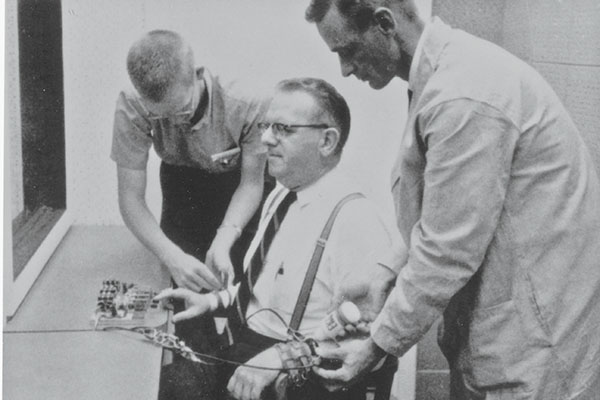
Scientists routinely conduct experiments to check whether their speculations are right or not. Be that as it may, a few scientists have taken this to the extremes. For now, we’ve put on perspective eight of the most bizarre, freakiest, and utmost scariest experiments made for the sake of science.

The Vomit Drinker
In 1804, American doctor Stubbins Ffirth firmly believed that the deadly yellow fever was not infectious. In order to prove that he was right, he performed some revolting experiments to test his idea. He would take some black vomit, saliva and blood from actual yellow fever patients and put them into inflicted wounds in his arms. The creepiest and most disgusting thing that he did was drinking the bloody black vomit and rubbing some of the vomit into his eyes. He considered his case proven when he didn’t get infected.
But, how is this disease really transmitted? Mosquitoes.

Drugged Spiders
Spiders intuitively weave flawless networks of webs to catch their prey. This impressed German researcher Peter Witt. And, in 1948, due to some tinkering around with drugs, he found that offering medications to these creepy crawlies made them weave abnormal webs. He then spent his ENTIRE lifetime indicating how distinctive medications modified the design of a spider’s web. Now, that’s dedication.

The Space Experiment
How would you test what happens to the body amid a long space venture without really going into space? In 1986, specialists in Moscow, Russia, recreated the weightless states of space by keeping 11 male volunteers lying on their backs for 370 days. In spite of some exercises performed on their backs, the outcomes indicated contracted muscles, lighter bones, and appalling weariness and anxiety.

The Living Dead
Breathing life back into the dead was the objective of American scientist and child prodigy Robert Cornish. In 1934, he ressurected a dead canine named Lazarus utilizing medications and a sort of teeter board to get the blood circulating. Because of his success, he requested that he attempt the method on a death-row inmate but his request was denied by California Law Enforcement because of concerns that a reanimated murderer would have to be freed under the “double jeopardy” clause.

The Autojector
Sergei Brukhonenko was a Soviet physician who experimented and developed a primitive heart-lung machine which he called an “autojector”. With this crazy device he succeeded in keeping the severed head of a poor dog alive. In 1928, one of his living dog heads was displayed in front of an international audience of scientists. Brukhonenko proved that the head was alive by banged a hammer on the table (wherein the head flinched), shining light in its eyes (the eyes blinked) and feeding the head a piece of cheese.

Real Beheading Experiments
In 1924, American psychologist Carney Landis felt the urge to know if individuals produced the same facial expressions under the same emotions like shock, distress, sadness and happiness. He took photos of volunteers as they were presented to different encounters, including requesting that they behead a live rodent! 2/3 of the volunteers beheaded the rats themselves. For those who couldn’t behead the rats, Landis did that for them instead. He found out that there was no universal expression for each emotion.

Obedience Test
In 1963, American analyst Stanley Milgram conducted a controversial obedience test experiment. He tested if that individuals would complete atrocious acts if requested to by a power figure or a person with authority. An amazing 65 percent of members gave in and performed what they believed were deadly electric stuns to a concealed person in another room.
Testicle Transplant Experiments
Dr. Leo Stanley was the chief physician of San Quentin prison from 1913 to 1951. He believed that male criminals had low levels of testosterone and that raising testosterone levels in inmates would greatly decrease criminal behavior. This prompted him to conduct crazy testicular experiments wherein he surgically transplanted the testicles of newly executed criminals into live prisoners. However, there was a lack of testicles for his experiments since only 3 executions in one year took place. This lead Quentin to use different animal testicles that he would liquify and inject into the prisoners’ skin.

The Stargate Project
Believe it or not, the US Army was interested in psychic phenomena and tried to find out if they could use this to their own advantage. Thus, the Stargate project was born – a research project involving remote viewing or the ability to see from a distance through psychic means. After about 20 years of zero useful information gathered, the $20 Million project was eventually shut down.

Vaginal Surgery Without Anesthesia
In the 1840’s, J. Marion Sims conducted an extensive surgical study on several female African-American slaves. This study, which spanned 3 years focused on finding a surgical cure for vesicovaginal fistula, a condition that abnormally connects the bladder to the vagina. But here’s the shocking part – he performed the surgeries without anesthesia! A woman named Anarcha, one of Sims’ subjects, endured a staggering 30 operations without anesthesia before he finally got it right.

Two Headed Dogs
In 1954, Vladimir Demikhov created something that the world hasn’t ever seen before – a two-headed dog. He did this by grafting the head, shoulders, and front legs of a puppy onto the neck of an adult German shepherd. When he paraded his creations, he let them simultaneously drink milk. Milk drank by the puppy would drip down the unconnected stump of its esophageal tube much to the dread of the people watching.

